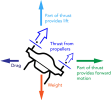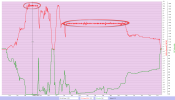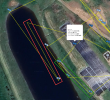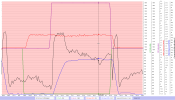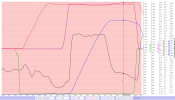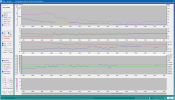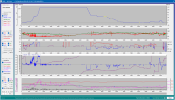This thread might raise an interesting discussion of a seemingly very simple question, " how does a drone descend under control ? "
My initial thoughts were it slows the motors and that is true............but.....
If the motors slow their propellers produce less thrust, if the sum of the vertical components of the thrust from each propeller is less than the thrust needed to counter act gravity then the drone accelerates downwards.
It then occurred to me that in order for the drone to descend in a controlled manner at a specific speed the vertical components of the prop thrust and aerodynamic drag must be more or less equal to the force required to counter act gravity. Variations away from that 'balance' would result in an acceleration either upwards or downward.
Think of travelling in a lift, your apparent weight changes when the lift is accelerating, when the lift is travelling at a constant speed then your weight seems the same as normal.
This morning another variable entered my head but my physics is too rusty to work it out.
When the drone is descending it is losing gravitational potential energy, the question that came into my head was, "does this loss of potential energy have an effect on the required motor rpm ?".
A question for perhaps
@sar104
With drones where the DAT can be read one can check the motor speeds during descent and they are slowed somewhat during a descent, I recollect checking this and in some cases the slowing struck me as quite significant and in others it struck me as fairly small (relatively speaking).
Unfortunately with the
mini 4 pro's I think the DATs from both the screen device and the drone are encrypted.....that's a pity.
It might be interesting to perform some experiments in this area, I do not have a
mini 4 pro so I can't do them.
My first suggestion would be to set the stick gains to what ever value, ( 0.5 ? ), gives a straight line response in the associated plots, I think that you can now do this in the fly app.
I would then make throttle-fully-closed descents at various CONSTANT elevator settings and hold the individual elevator settings for long enough for the drone to reach a steady horizontal speed, it would need a wind less day, if you get them there.
Process the flight logs with CsvView and look to see what the speed vs height plots or z vs h speed plots show.
I am just wondering if this behaviour starts at a certain speed.
It might also be interesting to see what happens whilst the drone is accelerating horizontally.
You can probably control acceleration by very careful movements of the elevator joystick but it might be an idea to check if it is possible to change the horizontal acceleration limits in the fly app. I have never looked into that so have no idea if there is such a feature even in the likes of Go & Go4.





